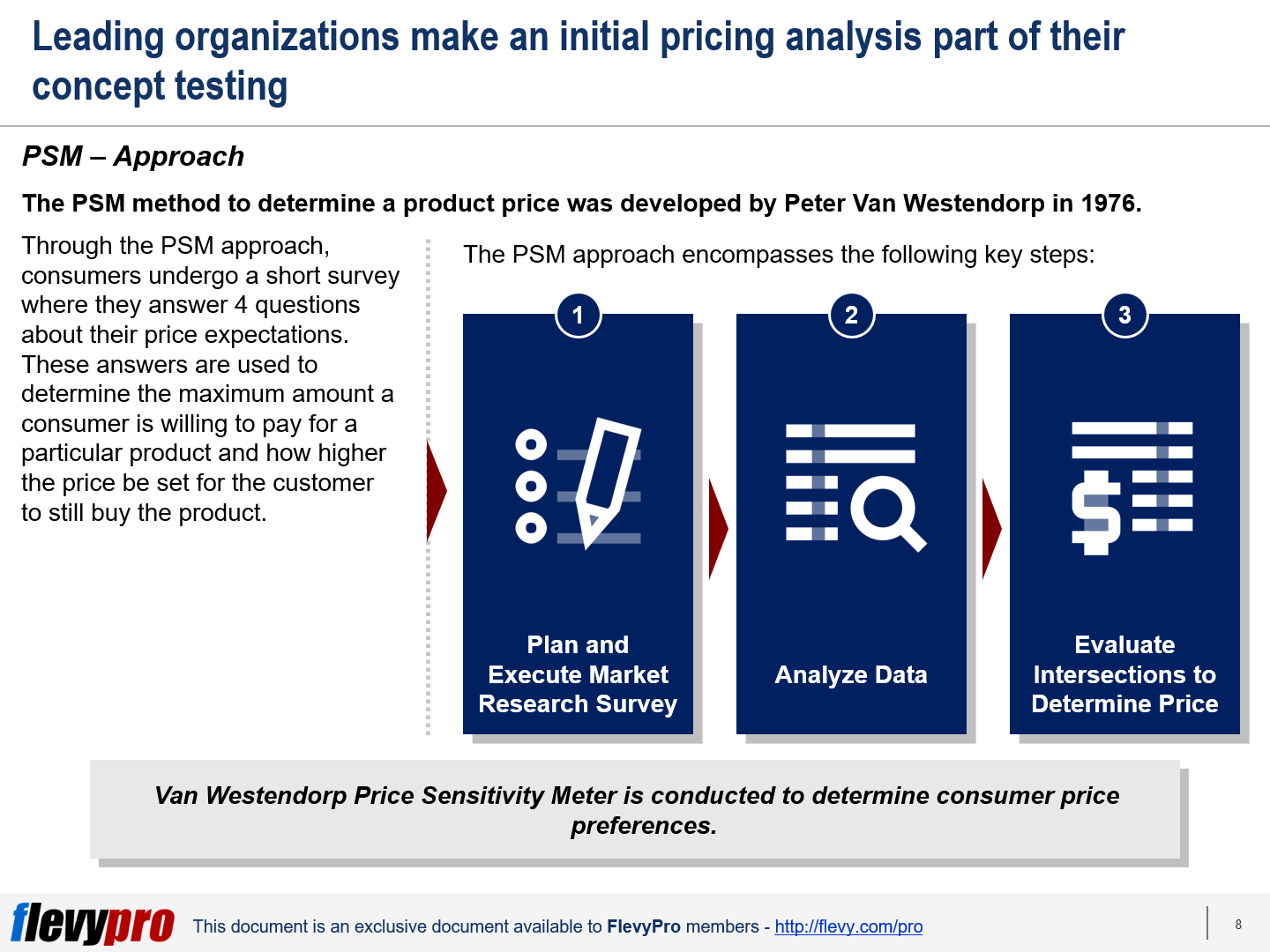Editor's Note: Take a look at our featured best practice, Pricing Strategy (38-slide PowerPoint presentation). Pricing Strategy is a core pillar of Marketing and Product Strategy. It is 1 of the 4 Ps of Marketing (also known as the Marketing Mix - Product, Price, Placement, and Promotion). As such, knowing how to properly price your product is extremely important to the commercial success and viability of [read more]
Also, if you are interested in becoming an expert on Strategy Development, take a look at Flevy's Strategy Development Frameworks offering here. This is a curated collection of best practice frameworks based on the thought leadership of leading consulting firms, academics, and recognized subject matter experts. By learning and applying these concepts, you can you stay ahead of the curve. Full details here.
* * * *
 The decision for pricing a product or service isn’t as simple as it seems. It is a key consideration for executives. Pricing way above the rival products risks not attracting the required customers while charging way below the competitor products could be equally detrimental.
The decision for pricing a product or service isn’t as simple as it seems. It is a key consideration for executives. Pricing way above the rival products risks not attracting the required customers while charging way below the competitor products could be equally detrimental.
Manufacturers can utilize research to have a better understanding on what consumers are willing to pay for a product. There are a host of research-based pricing approaches available—e.g., Monadic, Sequential Monadic, Conjoint Analysis, Van Westendorp Price Sensitivity Meter etc.—however, researchers often get confused on which one to use in a given product development phase. Let’s discuss the Van Westendorp Price Sensitivity Meter approach for now.
The Price Sensitivity Meter (PSM) is an easy-to-use method of evaluating price of a new product. The method was developed by Peter Van Westendorp in 1976. Through the PSM approach, consumers undergo a short survey where they answer 4 questions about their price expectations. These answers are used to determine the maximum amount a consumer is willing to pay for a particular product and how higher the price be set for the customer to still buy the product.
The approach offers a ball-park figure for the price of a product, is easy to administer, requires less effort from the consumers, and the PSM results are communicated in the form of simple diagrams. The approach, however, surveys only the “willingness to pay” attribute of a product, and is more appropriate for innovative products—as it is not easy to determine prices with competing products using this approach. PSM analysis should be a part of your Pricing Strategy process.
The PSM approach encompasses the following key phases:
- Plan and Execute Market Research Survey
- Analyze Data
- Evaluate Intersections to Determine Price

Let’s discuss the first 2 phases of the approach.
Plan and Execute Market Research Survey
The initial phase of the PSM research entails deciding on the medium of the study and planning the logistics, design, resources, guidelines, and governance protocols for the survey. More specifically, the phase involves:
- Preparing the field research plans.
- Determining whether the survey should be conducted online, telephonically, or face-to-face.
- Identifying the consumers (respondents).
- Assigning the required resources to the survey.
- Getting the data collection tools and research instrument (questionnaire) ready.
- The questionnaire includes the following questions:
- At what price the product would become so expensive for you to even consider buying it?
- Indicate the price that is expensive for you but you would still buy the product?
- What would be the price that is too cheap for the product where you would start doubting its quality and not buy it?
- Indicate the price of the product where you would consider it a great value for money (a bargain)?
- Gathering data from the survey participants.
Analyze Data
The second phase pertains to analyzing the respondents’ data from the field survey. This is done once the field data has been validated and cleansed of any inconsistent errors. The steps taken in this phase include:
- Ordering the 4 questions in a manner that it ranks prices as “Too Cheap,” “Bargain,” “Getting Expensive,” and “Too Expensive.” The values of these ranks should be kept in numeric dollar values.
- Plotting the responses of the survey participants on a graph.
- Depicting the prices on the X-axis.
- Representing the percentage of consumers who quoted the respective price (i.e. the cumulative frequency) on the Y-axis.
- Reversing the values of the two curves.
- The curves with the values “Too Cheap” and “Too Expensive” are drawn with inverse values. This creates two other curves. These curves show the percentage of consumers who regard prices as “Getting Expensive” and “Bargain”.
Interested in learning more about the other phase of the Van Westendorp Price Sensitivity Meter? You can download an editable PowerPoint on the Price Sensitivity Meter (PSM) here on the Flevy documents marketplace.
Do You Find Value in This Framework?
You can download in-depth presentations on this and hundreds of similar business frameworks from the FlevyPro Library. FlevyPro is trusted and utilized by 1000s of management consultants and corporate executives. Here’s what some have to say:
“My FlevyPro subscription provides me with the most popular frameworks and decks in demand in today’s market. They not only augment my existing consulting and coaching offerings and delivery, but also keep me abreast of the latest trends, inspire new products and service offerings for my practice, and educate me in a fraction of the time and money of other solutions. I strongly recommend FlevyPro to any consultant serious about success.”
– Bill Branson, Founder at Strategic Business Architects
“As a niche strategic consulting firm, Flevy and FlevyPro frameworks and documents are an on-going reference to help us structure our findings and recommendations to our clients as well as improve their clarity, strength, and visual power. For us, it is an invaluable resource to increase our impact and value.”
– David Coloma, Consulting Area Manager at Cynertia Consulting
“As a small business owner, the resource material available from FlevyPro has proven to be invaluable. The ability to search for material on demand based our project events and client requirements was great for me and proved very beneficial to my clients. Importantly, being able to easily edit and tailor the material for specific purposes helped us to make presentations, knowledge sharing, and toolkit development, which formed part of the overall program collateral. While FlevyPro contains resource material that any consultancy, project or delivery firm must have, it is an essential part of a small firm or independent consultant’s toolbox.”
– Michael Duff, Managing Director at Change Strategy (UK)
“FlevyPro has been a brilliant resource for me, as an independent growth consultant, to access a vast knowledge bank of presentations to support my work with clients. In terms of RoI, the value I received from the very first presentation I downloaded paid for my subscription many times over! The quality of the decks available allows me to punch way above my weight – it’s like having the resources of a Big 4 consultancy at your fingertips at a microscopic fraction of the overhead.”
– Roderick Cameron, Founding Partner at SGFE Ltd
“Several times a month, I browse FlevyPro for presentations relevant to the job challenge I have (I am a consultant). When the subject requires it, I explore further and buy from the Flevy Marketplace. On all occasions, I read them, analyze them. I take the most relevant and applicable ideas for my work; and, of course, all this translates to my and my clients’ benefits.”
– Omar Hernán Montes Parra, CEO at Quantum SFE

47-slide PowerPoint presentation
There are 3 common approaches to pricing: Cost-based Pricing, Competitive Pricing, and Value-based Pricing.
Value-based Pricing offers numerous distinct advantages over the other 2 pricing methodologies. It is particularly suitable for situations where you are entering a new market, offering a
[read more]
Want to Achieve Excellence in Strategy Development?
Gain the knowledge and develop the expertise to become an expert in Strategy Development. Our frameworks are based on the thought leadership of leading consulting firms, academics, and recognized subject matter experts. Click here for full details.
"Strategy without Tactics is the slowest route to victory. Tactics without Strategy is the noise before defeat." - Sun Tzu
For effective Strategy Development and Strategic Planning, we must master both Strategy and Tactics. Our frameworks cover all phases of Strategy, from Strategy Design and Formulation to Strategy Deployment and Execution; as well as all levels of Strategy, from Corporate Strategy to Business Strategy to "Tactical" Strategy. Many of these methodologies are authored by global strategy consulting firms and have been successfully implemented at their Fortune 100 client organizations.
These frameworks include Porter's Five Forces, BCG Growth-Share Matrix, Greiner's Growth Model, Capabilities-driven Strategy (CDS), Business Model Innovation (BMI), Value Chain Analysis (VCA), Endgame Niche Strategies, Value Patterns, Integrated Strategy Model for Value Creation, Scenario Planning, to name a few.
Learn about our Strategy Development Best Practice Frameworks here.
Readers of This Article Are Interested in These Resources

56-slide PowerPoint presentation
Pricing products and services is one of the most complex and overlooked elements of a strategy. This document provides a guide and framework to help build better understanding of different strategies and tactics available.
Areas covered include:
Why is pricing important?
Pricing Strategy
[read more]

133-slide PowerPoint presentation
This is a presentation used for conducting a pricing workshop for your organization or a client's. It covers, among others, the following:
- Pricing framework & Implementation
- OEM pricing
- Distributor pricing
- New product pricing
- Bundle pricing
The presentation has 130 slides.
See
[read more]

63-slide PowerPoint presentation
This toolkit is focused on the point at which we actually ask the customer for a price increase. None of the strategic value of a pricing recommendation matters unless we take action with the customer. There are several tools and approaches that could make the increase more successful.
This
[read more]

23-slide PowerPoint presentation
- In many industries, price is a crucial lever for driving higher profitability. Nevertheless, many companies do not use a systematic process for price management. Applying best practices to the tactical execution of a price increase can significantly improve yield and help the organization to
[read more]
 The decision for pricing a product or service isn’t as simple as it seems. It is a key consideration for executives. Pricing way above the rival products risks not attracting the required customers while charging way below the competitor products could be equally detrimental.
The decision for pricing a product or service isn’t as simple as it seems. It is a key consideration for executives. Pricing way above the rival products risks not attracting the required customers while charging way below the competitor products could be equally detrimental.




